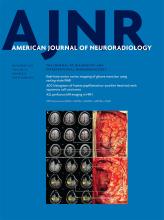Index by author
Qiu, D.
- EDITOR'S CHOICEAdult BrainOpen AccessThe Brain Thermal Response as a Potential Neuroimaging Biomarker of Cerebrovascular ImpairmentC.C. Fleischer, J. Wu, D. Qiu, S.-E. Park, F. Nahab and S. DehkharghaniAmerican Journal of Neuroradiology November 2017, 38 (11) 2044-2051; DOI: https://doi.org/10.3174/ajnr.A5380
The authors evaluated the use of noninvasive MR thermometry in patients with cerebrovascular disease, and hypothesized that the presence of a measurable brain thermalresponse would reflect the tissue hemodynamic state. MR imaging and MR thermometry were performed in 10 patients undergoing acetazolamide challenge for chronic, anterior circulation steno-occlusive disease. Cerebrovascular reactivity was calculated with BOLD imaging and arterial spin-labeling methods. Brain temperature was calculated pre- and post-acetazolamide using previously established chemical shift thermometry. They observed significant, voxelwise quadratic relationships between cerebrovascular reactivity from BOLD imaging and the brain thermal response and baseline brain temperatures, concluding that brain thermal response is a potential noninvasive biomarker for cerebrovascular impairment.
Qiu, T.-m.
- EDITOR'S CHOICEFunctionalOpen AccessReal-Time Motor Cortex Mapping for the Safe Resection of Glioma: An Intraoperative Resting-State fMRI StudyT.-m. Qiu, F.-y. Gong, X. Gong, J.-s. Wu, C.-p. Lin, B.B. Biswal, D.-x. Zhuang, C.-j. Yao, X.-l. Zhang, J.-f. Lu, F.-p. Zhu, Y. Mao and L.-f. ZhouAmerican Journal of Neuroradiology November 2017, 38 (11) 2146-2152; DOI: https://doi.org/10.3174/ajnr.A5369
The authors conducted preoperative and intraoperative resting-state intrinsic functional connectivity analyses of the motor cortex in 30 patients with brain tumors. Factors that may influence intraoperative imaging quality, including anesthesia type and tumor cavity, were studied. Additionally, direct cortical stimulation was used to validate the accuracy of intraoperative resting-state fMRI in mapping the motor cortex. Fourteen patients who successfully completed both sufficient intraoperative resting-state fMRI and direct cortical stimulation were used for further analysis of sensitivity and specificity. Compared with those subjected to direct cortical stimulation, the sensitivity and specificity of intraoperative resting-state fMRI in localizing the motor area were 61.7% and 93.7%, respectively. They conclude that using intraoperative resting-state fMRI can avoid the risk of intraoperative seizures due to direct cortical stimulation and may provide neurosurgeons with valuable information to facilitate the safe resection of gliomas.








